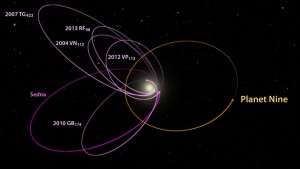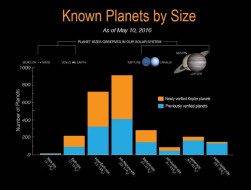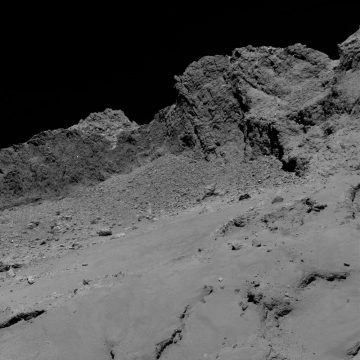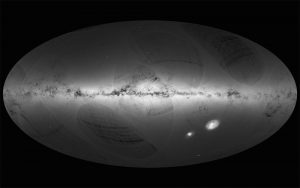From the discovery of gravitational waves to the building evidence that a massive planet could exist beyond Pluto, it has been a thrilling year for astronomy news. We recap.

Swinburne Astronomy Productions
The discovery made headlines worldwide and even appeared on The Late Show with Stephen Colbert. After more than a half-century of searching, physicists finally detected gravitational waves — ripples in the fabric of spacetime — from two colliding black holes. Scientists went wild.
But gravitational waves weren’t the only news that made 2016 a truly momentous year in astronomy. Scientists also discovered thousands of new worlds (one so close we could reach it in 4.2 years if we traveled at the speed of light) and launched missions to nearby solar system planets.
Although these stories easily top our “greatest hits” list below, not all stories arrive with such a crashing impact that they immediately change how we perceive the universe. Most unfold slowly. Those stories are the ones that are truest to the scientific process as it zigzags toward the truth. So as we review 2016’s top astronomy news stories, we’ll also review milestones, including a new data release that’s bound to remap the galaxy, and other tales of unsteady progress, such as changes in our thinking on dark matter.
It’s worth mentioning that 2016 also pulled the Moon a tad closer to Earth, revealing a supermoon that caused a ruckus of responses. And it pushed a few notable people away from us with the passings of John Glenn and Vera Rubin.
Planet Nine?

Caltech / Robert Hurt
It has been almost a century since Percival Lowell — the astronomer who predicted the existence of a “Planet X” beyond Neptune — died. But the hunt is still on. In January, Konstantin Batygin and Michael Brown (Caltech) presented evidence (in the form of slight orbital quirks among some of the solar system’s most distant objects) that suggests a massive planet, perhaps 4 times the size of Earth, lurks in the outer solar system. If true, the discovery would rewrite those kindergarten lesson plans.
Gravitational Waves
The detection of gravitational waves heralded a new era in astronomy — one in which scientists could study exotic and otherwise-invisible cosmic phenomena for the first time. As LIGO executive director David Reitze said during the announcement: “This was truly a scientific moonshot, and we did it, we landed on the Moon.” But unlike the race to the Moon, which abruptly ended in 1972, LIGO shows no sign of quitting: it has already detected a second black hole collision and begun another run of observations.
An Odd Star Caused Astronomers to Speculate Beyond Your Wildest Dreams
Tabby’s star, or KIC 8462852, could be the result of a vast “alien megastructure.” At least that’s one astronomer’s explanation for its erratic behavior (and the reason the star made so many headlines in February). But the more astronomers monitored the star, the weirder it became. On top of the erratic dimming, it has gradually dimmed over the course of a century and a few years (both at different rates). And it’s these differing trends that leave astronomers scratching their heads.
Kepler Discovers Over 1,000 New Planets

NASA Ames / W. Stenzel
In May, the number of known worlds beyond the solar system swelled. NASA’s Kepler space telescope increased its catalogue by an additional 1,284 worlds — the greatest number of planets ever announced at a single time. Although it brings Kepler’s confirmed planetary haul to more than 2,000 exoplanets, the list is nowhere near complete. With another year and a half of data to gather and 2,000-plus candidates still on the wait-list, more discoveries are likely to come.
The Missing Satellite Problem is Solved?
Astronomers have long wondered why the Milky Way doesn’t have thousands to millions of small satellite galaxies swarming around it, like bees around a hive. Simulations of galaxy formation predicted it should, but observations have only nailed down a few dozen dwarf galaxies. Then in May, astronomers added baryonic matter and physics to their models — instead of just dark matter and gravity (an assumption that works well on large scales) — and caused those extra galaxies to vanish. Not only may the new simulation finally put the cosmological mystery to rest, but it creates galaxies that are eerily real.
Dark Matter Remains Elusive
It has been a rough year for dark matter. The newest searches for weakly interacting massive particles (WIMPs) have come up empty-handed. First, an underground detector in South Dakota called the Large Underground Xenon detector failed to detect any WIMPs. Then, the Antarctic observatory known as IceCube ruled out a fourth type of neutrino and dark matter contender. Physicists might soon be turning toward more exotic theories.
Our Neighboring Exoplanet
In August, astronomers found an exoplanet that was both habitable and in the closest alien star system — two characteristics that made Proxima Centauri b’s announcement a once-in-a-lifetime discovery. Of course, whether the planet actually is habitable remains an open question. Because astronomers only know the planet’s minimum mass, orbital period, and distance from the star, they can’t say for sure. Still, it’s enough to encourage interstellar imaginings.
Rosetta’s Big Crash

ESA
On September 30th, the European Space Agency’s historic Rosetta mission to explore Comet 67/Churyumov-Gerasimenko ended with a crash — purposefully. For two years the spacecraft shadowed the comet through deep space, revealing an alien world of soaring cliffs, hissing jets of water, and even trails of organic chemicals. Still, those images don’t compare to the close-up views that Rosetta was able to capture as it descended toward its final sleep.
Juno Slips into Orbit
NASA’s latest mission to the outer solar system sent back some gorgeous photos as Juno swept just 2,600 miles above Jupiter’s brown and white cloudtops. Although Juno was set to shorten its orbit from 53.4 days to just two weeks, an anomaly experienced by a set of valves that control the spacecraft’s fuel pressurization encouraged mission scientists to delay the change. Today, Juno still orbits at its initial speed. But that hasn’t kept mission scientists from learning a few of the planet’s mysteries, like the fact that Jupiter’s bold, colorful stripes penetrate deep into its atmosphere.
ExoMars Runs into Success and Failure
It was an eventful year for space missions. After a 7-month journey from Earth, the ExoMars Trace Gas Orbiter settled into its new home high above the Red Planet. Unfortunately, its lander, Schiaparelli, crash-landed into the surface after a fatal plunge. It was a particularly sad loss given that Schiaparelli would have been the first successful non-U.S. lander on Mars. Still, scientists remain hopeful that that will change in 2022, when the Russian and European space agencies attempt to land a rover intact based on the lessons learned this year.
Gaia Redraws the Galactic Map

ESA / Gaia / DPAC
In September, the Gaia spacecraft released its first set of data — a gold mine that 10,000 astronomers accessed on the first day alone. The excitement is understandable: by the end of its five-year-long run, Gaia will pinpoint the positions of one billion stars on the sky to an accuracy that’s hundreds of times better than today’s best catalogue. But there’s more: Gaia will also chart each star’s distance and two-dimensional velocity, creating a new, 3D map of the Milky Way.
Pluto Continues to Surprise
It has been over a year since NASA’s New Horizons spacecraft came face to face with Pluto and revealed a world composed of towering mountains, potential ice volcanoes, and even a bright patch in the shape of a giant heart. But the discoveries continued to roll in in 2016. Scientists determined that Pluto likely once had — and might still have — a briny ocean beneath its surface, that its atmosphere is far more dynamic than imagined, and that Sputnik Planitia caused its entire crust to shift as it filled with frozen nitrogen over time. The dwarf planet, which most scientists had assumed was geologically bland, couldn’t be more thrilling.
Stay abreast of developments in astronomy — from science and celestial event to new equipment — with a subscription to Sky & Telescope magazine.
 2
2









Comments
John-Murrell
January 2, 2017 at 2:52 pm
The Gaia image is interesting as it does not actually show the stars measured by Gaia so far - there are too many to show them individually. Even on a high resolution display there are around 1k stars that need representing for each Pixel. The image above is in fact a logrithmic plot of the number of stars in each pixel. There is a more detailed explanation of the problem and the solution on the Gaia 'image of the week' at http://www.cosmos.esa.int/web/gaia/iow_20161223 which shows the impact of attempting to plot 1M stars and the solution.
It is interesting to note that we now have so much data that we are not even able to visulise it directly - Data mining 2 billion stars with perhaps 1k measurements of each is an interesting challenge for both proffesional and amateur astronomers.
You must be logged in to post a comment.
Graham-Wolf
January 5, 2017 at 6:13 pm
Nice work, Shannon.
Really appreciate your "breezy" free-flowing journalistic style.
Nice bio on Vera, recently.
Very tough having to choose just 12 "top stories of 2016" from hundreds of good candidates, but you sure did it!. Always knew the Pluto mission would make the "cut". Made Clyde a very happy "chappie".
Regards from 46 South, NZ. Graham W. Wolf
You must be logged in to post a comment.
You must be logged in to post a comment.